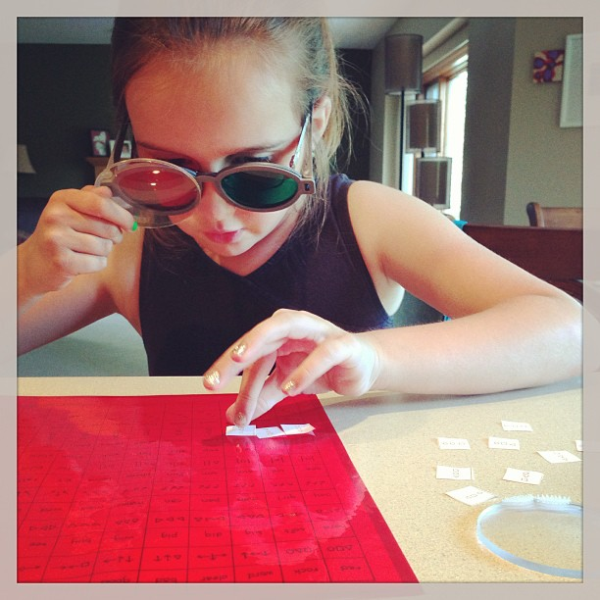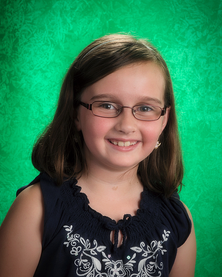
Why is it that so many kids with vision problems don’t get treatment? In cases of amblyopia, it’s often because the kids don’t even realize they have a vision problem. For Maya’s family, the discovery that their daughter had ‘lazy eye’ was a huge surprise.
As Maya’s mom Molly recalls, she and her husband didn’t really even notice that Maya had a problem. Even though she had amblyopia and her brain was using her left eye very differently from the right eye, Maya was reading and had good grades. Her teacher never mentioned any problems either.
“We never thought anything was wrong,” Molly said.
One day, Maya was sitting with her father, reading a Dr. Seuss book, when she closed her right eye and tried to read. She couldn’t.
The family brought Maya to her optometrist, Dr. Kelly Collins in New Berlin. She was diagnosed with amblyopia. Dr. Collins referred the family to Dr. Knueppel and The Vision Therapy Center, where Maya went through two functional vision tests.
After the testing, Molly and her husband met with Lisa Dudzinske, a vision therapist who helps parents understand their child’s vision problems.
“It was an eye-opening experience,” Molly recalls.
Lisa proceeded to describe many of Maya's symptoms, typical of a person with amblyopia. She was a little bit clumsy, and occasionally reversed letters. She also had an inability to make quick decisions, and she often struggled with homework.
“I thought it was growing up problems,” Molly said. “Then we learned all the issues were vision-related.”
When she heard the news, Molly broke down and started crying. “I felt like I had been nagging Maya on her homework,” she said.
Lazy Eye Issues Difficult to Spot
It’s no surprise that the family was surprised. Amblyopia may not have any outwardly-visible symptoms. The condition may not involve an eye turn, or crossed eyes, such as strabismus. In fact, a child’s appearance is often normal.
However, many children will experience the telltale clumsiness that Maya exhibited. Amblyopia is a sign of poor vision development, and the visual system leads the way in gross and fine motor development.
The reason that Maya could not read the Dr. Seuss book when she closed one of her eyes is that her brain used her two eyes very differently. As a result, the visual acuity, or sharpness of vision, in the amblyopic eye did not develop to the level of the other eye and was poor enough to prevent her from reading.
Following the diagnosis, the family decided to begin vision therapy right away.
Maya did 30 days of syntonics, or light therapy. “Hunkered down in her bedroom closet,” she looked at red and green lights. Initially Molly was uncertain about syntonics, but after the therapy, she noticed that Maya’s focus was better, and that her eye didn’t seem as tired.
Following the syntonics, Maya began weekly visits with Cindy, her vision therapist. With her two sons in tow, Molly recalls the whole family “got to know the VT center.” In addition to the office visits, Maya did home therapy 5 times during the week, which lasted 25 to 30 minutes.
“At first, Maya had a blast,” Molly said. “Then it became a struggle.”
A Challenge Yields Big Results
The family would try to do vision therapy before school, then after school, always looking for times when Maya was most rested. No matter when they tried, the therapy proved difficult.
“There were lots of weeks when I would have to talk to Cindy to figure out how to get through this,” Molly said. “But I couldn't blame her. She was a little 7 year old girl who wanted to play.”
Eventually, the family made it through. Today, Molly can see a difference in her daughter’s writing. “Her letters never used to be even – they would slant on the page. And some would be big, some small,” she said. Maya also stopped reversing so many letters.
Her clumsiness went away, too, as Maya began to excel in softball. She was finally able to catch pop-ups.
The change in the classroom and in athletics also translated into a change in personality. “She is more out of her shell,” Molly said. “She wants to do sports now.”
Vision therapy changed the way her brain used the amblyopic eye, resulting in improved binocular vision and acuity in that eye.
Once her visual system began functioning normally, her depth perception improved. Those softball catches became easier.
Improved depth perception also helped Maya overcome her clumsiness. Now she could effectively judge where objects were in space, and react accordingly.
Maya’s story holds two important lessons for parents: First, just because a child is doing well in school doesn’t mean he or she doesn’t have a vision problem. Children (and adults) can find ways to adapt and work around a vision problem.
Maya, for example, just read with one eye. Over time, however, this adaptive strategy would have failed her. She was already starting to slow down on her homework. As coursework became more difficult, she would have struggled to keep up.
Second, be sure to look for solutions, even when everyone is telling you there’s nothing wrong. Trust your gut instinct. Time and time again, we’ve had cases where educators and/or doctors don’t understand the issues surrounding a functional vision problem, and will tell a family that a child is fine.
In Maya’s case, no one denied there was a vision problem – they just simply didn’t see a problem at all. She was doing fine in school. But Molly and her husband knew that something wasn’t right, especially after the Dr. Seuss incident.
Trust your instincts, folks. It can make a world of difference. Just ask Maya.

